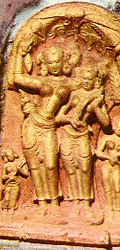In Eastern religious art, there are various body postures, hand and leg positions with different symbolic meanings. They express the mood and meaning of images of Buddhist, Hindu or Jain deities. Images of Buddha are made standing, seated,
There are three standing positions: straight upright, a twofold contraposto called (abhanga), and a threefold posture called (tribhanga). An upright figure with one foot forward and the other slightly bent behind is the walking position.
 |  |  |  |
| Abhanga | Tribhanga | Upright | Walking |
In reclining postures, the position of the head resolve the meaning. The head pointing toward north denotes attaining nirvana or death. The rest are simple recumbent figures at leisure.
 |  |
| Nirvana | Leisure |
 Virasana |  Vajrasana |  Rajaliasana |  Lalitasana |
Hand gestures are known as mudras. If the right hand is down and palm face inward, the gesture is known as the earth touching attitude or calling the earth for witness (bhumiphasa mudra). When the hand is raised with palm outward, facing the viewer, it is the gesture of protection (abhaya mudra). If the hand has palms outward but the hand pointing downward, it is the gesture of bestowing (varada mudra). When thumb and index finger are joined in a circle, the gesture means teaching or having a discussion (vitarka mudra).
If the two hands are placed face to face with the index of one hand touching the circle joined by the thumb and the index finger of the other hand, it is the gesture of turning the wheel of the law of motion (dharmachakra mudra). When a seated image has both hands placed palms upward and rest on the lap, it is the gesture of meditaion (dhyana mudra). Both hands clasped and raised to the chest is the gesture of obeisence (anjali mudra).
 Abhaya mudra |  Varada mudra |  Vitarka mudra |  Dharma-chakra mudra |
 Bhumiphasa mudra |  Dhyna mudra |  Anjali mudra |
Metta,
Ba Kaung

No comments:
Post a Comment